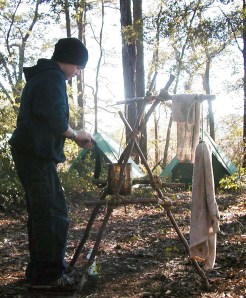
Back in the spring of 1976, while walking through the Mortimer L. Schiff Scout Reservation, then the BSA National Training Center, there was a memorable encounter with a tall man. Seeing the young Scouter, the tall man figuratively embraced him with a smile, warmly acknowledging the younger man like they were lifelong brothers in a worldwide family. A light-hearted conversation ensued. The tall man was Ken Cole, Jr., editor of the 1967 edition of the Boy Scouts of America Fieldbook which had just recently been reprinted.

Here’s an amusing side note: With a twinkle in his eye, he related a little “story” about how on his flight over to Schiff, a passenger sitting next to him in the smoking section asked him for a light. He described how he casually retrieved some belly button lint from a plastic bag, and nonchalantly lit the man’s cigarette with flint and steel. Boy, was that guy ever surprised. The account was related with such sincerity, the thought whether or not this actually happened never occurred to the young man. Ken was so engaging and easy to be around, it really didn’t matter.
Ken happened to be carrying a bow saw, and extolled its virtues as a most useful woods tool. He then bragged about how wonderful was the dovetail notch, and proceeded to effortlessly create one in a stick he picked up from the side of the path. It was a happy demonstration. Ken was a very happy guy.

There’s a whole section on “dovetailing” in the 1981 printing of the BSA Pioneering Merit Badge Pamphlet: “With the handy bow saw and a pocket knife, you can make excellent joints for log structures without lashings. This is done by making a triangular notch in the “receiving” log and a tapered end in the other log or pole. This is called “dovetailing” and if done correctly, it provides a tight, rigid joint that is neat and strong.”

The following is extracted from the 1976 Boy Scout Fieldbook:
When you must hold two pieces of wood together, and you don’t have rope for lashing and there are no nails or wire, you can do it with a dovetail notch. The dovetail joint, as you know, is a familiar cabinet makers trick. However, you don’t have to be a skilled carpenter to make this dovetail notch. Four cuts by a saw and a few strokes with your knife to pry out the wood in the notch is all there is to it. The notch will hold slender unshaped round sticks for quick work and thicker tight-fitting dovetails for heavy loads.





